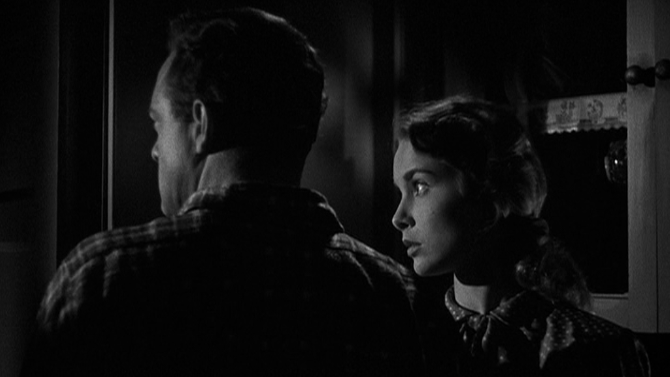A perfect example of ‘you can’t outrun your past, present or future’, 1949’s Act of Violence, directed by Fred Zinnemann (High Noon; From Here to Eternity), starts with quite the hook: a man, limp noticeable, hurriedly, and with purpose, makes his way through a city in the clutches of the glum night, eventually entering a room that holds a deadly object – a gun. . . hopping onto a bus, it does not bode well.
With a deliberate, unyielding presence, Joe Parkson (Robert Ryan – for another one of his great film noirs, see The Set-Up) is the thing of nightmares. . . a stalking figure in trench coat and fedora – the Michael Myers of the noir genre. Ryan, with his lined face, imposing size, and disturbed demeanor, is an ominous heavy – the enigmatic grunt opening a phone book and circling the name of one Frank R. Enley (Van Heflin).
More of an everyman with a less threatening look, Enley is a thriving post-war family man living in small town western USA – earning a healthy living, he also has a much younger wife, Edith (Janet Leigh – Psycho), and a healthy child. Though it takes Enley some time to realize he has an unwavering presence tracking him, when he does learn the disturbing news, he seems altogether unsurprised.
Like so many other men who came back after World War 2, Enley has kept his past life a secret. . . including his ties to his former friend and bombardier Parkson. What we do know, the pair were shot down and placed in a prisoner of war camp for more than a year. With a brilliantly filmed climax set in a train station – it is a location where time meets fate. . . a possible locomotive last breath?
With a special visual panache, cinematographer Robert Surtees (The Sting) douses the noir with dark shadow and harsh light – bringing the seedy noir atmosphere and its pessimistic viewpoint (that usually finds itself in the crime-filled city) to the quaint, comfortable and seemingly pure place that is small-town America. Also echoed in Zinnemann’s visuals (long takes, deliberate pacing), it is perhaps best exemplified, though, in a more unique way – numerous examples of superlative sound design. . . the cheerful ring of the doorbell anything but; the ticking of the alarm clock indicating the fearful anxiety of Enley as he tries to sleep while Parkson sits in a car outside; the toot of a train horn off in the distance as Enley struggles with his predicament – possible suicide?; a car driving away or door closing – Edith so worried about her man. . . what is heard off screen in many ways tells us as much as what we see onscreen.
One of the first films to deal with the war in a less positive way, it is a tale of the time. Ethics, troublesome pasts, loss, revenge, psychological wounds all come out of Collier Young’s story (adapted for the screen by Robert L. Richards), the unenviable struggle of war – sometimes allowing people to do questionable things that they justify with flawed logic. Its moral ambiguity will likely have people falling on each side of the scenario – living in the grey milieu that is life, Zinnemann’s background, born to Austian-Jewish parents (escaping with his brother in 1938, their parents were less fortunate – dying in concentration camps while waiting for U.S. visas that never came) likely helped frame this compelling tale.
A rare feature from the time that posts its credits after the film (and not during the main credits), it stands out – helping draw our eyes to the superb cast. On top of the stars referenced above, Mary Astor (The Maltese Falcon) has a sharp little role as a worn hooker named Pat – living a tiring life that has left her a bar-hopping, money desperate dame, she plays a part in Enley’s desperate search for survival – introducing him to Johnny (Berry Kroeger – Gun Crazy), a true to his word wildcard hit man who may decide the threatened guy’s fate (both literally and spiritually). Ann Sturges (Phyllis Thaxter) must also be mentioned – Parkson’s loving gal and his voice of reason that is constantly ignored.
With a fateful conclusion that feels both wholly unexpected yet seems like it could not have ended any other way (much like Stanley Kubrick’s The Killing), Act of Violence is a dynamic, fast-paced thrill ride. Featuring a well rounded score from Bronislau Kaper – that is at times frantically tense, at others, a deliberately slow theme that is as haunting as Parkson, it adds another layered level to the picture. Lastly, locations like Big Bear Lake, San Bernardino National Forest and the impoverished neighbourhoods of Los Angeles only add to its dynamic quality. So, don’t regret missing this classic film noir, it is a bullet-train of a picture.



